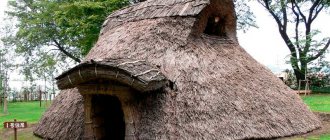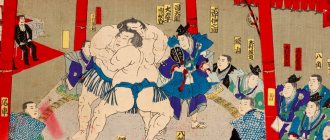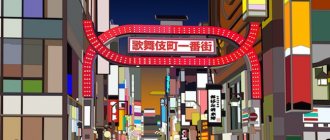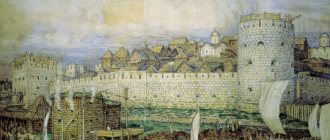tags:
Architecture, Japanese, Masterpiece, Japan, Building, Kyoto, Palace, Most
| The architecture of Japan is one of the few in the world whose works up to the mid-century. XIX century were built from wood. All the oldest surviving wooden buildings in the world (from the end of the 6th century) are located in Japan; in China they are not older than the 8th century, in Northern Europe - the 11th century, in Russia - the 15th century. The adoption of Buddhism gave a powerful impetus to the development of architecture, as well as the entire culture of Japan. |
Pre-Buddhist architecture.
What the pre-Buddhist architecture of Japan looked like can be judged by the buildings of two revered Shinto shrines, Ise and Izumo. The current buildings are not ancient, but reproduce expressive ancient forms: log buildings stand on stilts, have high gable roofs with a large canopy and cross-shaped beams protruding. Their forms were used as a guide during the restoration of most Shinto shrines in Japan in the 19th century. A characteristic feature of Shinto shrines is the tori gate, which marks the boundaries of the sacred territory; One of the symbols of the country is the tori shrines of Itsukushima (west of Hiroshima) standing in the water.
Here is a statue of Gyuze-Kannon, similar in style to the Shaka Triad.
History of Japanese architecture
The main feature of the architecture of ancient Japan was the construction of structures made entirely of wood, with a bulky massive roof and light, fragile walls. This is due to the humid and warm climate of the islands, which often receive fairly heavy rainfall, as well as periodic earthquakes.
Temple buildings in Japan are divided into 2 types based on religion: Shinto and Buddhist. Structurally, these buildings were built under the influence of Chinese traditions, but adapted to the local culture.
The main features of ancient architecture in Japan:
- The main material is wood, which is abundant in local areas. Thanks to it, buildings can withstand all the vagaries of nature, are easily disassembled and moved to another place.
- Strong gable roofs that withstand heavy rains well and curved eaves were built under the influence of Chinese architects, but they are more elegant.
- All buildings fit perfectly into the landscape; temples are most often located in a park or raised above the water on stilts.
- Ancient architects did not build individual objects, but entire complexes.
An example of such a building would be any religious building, consisting not only of the main temple, but also of the main gate (torii), treasury, library, multi-tiered pagoda and temple for sermons.
After accepting Buddhism
The adoption of Buddhism in the 6th century was the most important event in Japanese history. With Buddhism, the country joined the rich, centuries-old cultural traditions of Central, Southeast and East Asia and thereby moved to a new stage of development. Buddhism, which came to Japan from China through Korea, became the bearer of new forms of art. Chinese and Korean masters built the first Buddhist temples and monasteries. The Horyuji temple ensemble, erected in the first years of the 7th century, built in accordance with Chinese canons, has survived to this day. In the center of the vast complex is a rectangular courtyard, surrounded by covered galleries with gates on the south side and a sermon hall on the north. Inside the courtyard there is the main Golden Hall (Kondo) and a five-tiered pagoda rising 32 meters, ending with a spire with nine rings - a symbol of the Buddhist celestial spheres. The altar sculptural composition in the interior of the temple was the main shrine and its center. It was built like a stage: statues were placed on the altar dais in a certain order, in accordance with the place of deities in the pantheon. In the center was an image of Buddha, on either side of it were statues of bodhisattvas. Closer to the edges of the altar stood the defenders of the faith, sometimes in the guise of formidable warriors. In the Golden Hall of Horyuji, the center of the altar is occupied by the Shakyamuni Triad (Trinity of Buddha Shakyamuni), an outstanding example of early Buddhist sculpture in Japan. Adjacent to the walled area around the Golden Hall and the pagoda is another part of the complex, in the center of which is the octagonal Yumedono (Hall of Dreams) building.
In the 13th century. A new type of monastery is developing - the Zen school, in which all buildings are built along the north-south axis, opening up to the pilgrim in turn. As a rule, Zen monasteries were built on wooded mountain slopes and are perfectly integrated into nature; landscape gardens and so-called “rock gardens” are arranged in them. The most famous are the Five Great Zen Temples in Kamakura near Tokyo; Dating back to the 13th century, but preserving mainly late, relatively small buildings, these monasteries perfectly preserved the prayerful atmosphere imbued with close contact with nature.
Few authentic works of architecture from the 14th and 15th centuries have survived to this day. These include the Kinkakuji or Golden Pavilion, built in 1394, and the Ginkakuji or Silver Pavilion, built in 1489 as the villa of Shogun Ashikaga Yoshimasa and later became a Buddhist temple. The meaning of such works, their content, is revealed only in comparison with nature; architecture and nature become equivalent parts of the artistic image. But natural nature could not enter into this unity; it had to be artistically transformed by the garden master in accordance with the same principles that guided the architect of the pavilions. The garden was a necessary component of this architecture, since the very idea of connection, the unity of external and internal space was important here.
China.
From the time its main characteristics can be identified, the Chinese way of design has followed two principles: symmetry and south orientation. The same rules applied to building programs at every level, be it a city house, a temple, an office, or an imperial palace. The main idea is the rigid alignment of the object along the north-south axis. The main planning element was a walled courtyard with an entrance from the south in the center and with the main building located behind, against the northern wall. Typically, the hall in a house has an elongated rectangle in plan, located across the main axis, so that when viewed from the entrance gate, its hall reveals itself in the most spectacular way. Secondary auxiliary rooms are arranged symmetrically along the walls of the courtyard at right angles to the axis of the main hall. The expansion of this simple scheme amounted to the addition of another courtyard in front of the first, following the same axis. The complex of two gates perfectly suited the needs of a modest-sized estate, when the front courtyard was open to guests or business contacts, and the residential part was enclosed in the second courtyard. With further expansions, other courts were added, one after another, behind the primary core, or symmetrically to the left and right, resulting in the whole reaching the scale and complexity of the imperial palace.
The final expansion gave rise to a standard “chessboard” layout of the capital city, the streets of which were oriented according to the cardinal points, and the main street of increased width played the role of the central axis of symmetry. Moreover, the huge palace city occupies a vast rectangle in the center behind everything; both the palace itself and the city as a whole are surrounded by a wall, the main gate of which is made from the south. Deviations from this ideal design were allowed either in situations where the relief made this impossible, or when pictorial irregularity was set as a conscious goal of softening the rigidity of the plan.
The Chinese hall inside is organized no less formally than the plan of the entire building. Axial symmetry is absolute in terms of the arrangement of columns, the placement of doors, windows and other details. For both structural and artistic reasons, the front and rear facades are also identical. The main structural element is a pair of posts at the front and rear, a beam connecting them at the top, and a roof triangle at the top. With particularly modest dimensions of the structure, the roof ridge is supported by a post rising from the center of the beam. When the dimensions of the structure increased, a second, shorter beam was introduced, raised above the first on two thick short posts, reinforced approximately 1/4 of the span. The posts supporting the rafters are now placed on this second level. With a further increase in the width of the hall, the series of transverse beams becomes three-tiered. When the span reached its breaking point, further expansion of the hall was possible with the help of additional two or four pillars on the front and rear sides. Typically, these additional pillars were placed below the main pair to fit into the contour of the roof. Structural blocks of this kind were placed next to each other to cover the required span, then connecting them along the length with a system of beams, horizontal braces and a ridge. In large halls, it is the span between the main pair of central pillars that gives scale and expressiveness to the interior.
The formality of the Chinese layout is strictly consistent with the emphasized artificiality of the building's façade. At the same time, color is used in abundance: on large surfaces of walls or pillars, in bright patterns on beams and consoles, on glazed roof tiles, where the color is enhanced by the glare of the sun. The shapes of the roofs, rising above the wide extensions, are distinguished by geometric simplicity. There are three main types of roofs, used depending on the rank of the structure: concave for the most monumental structures, simple pitched for the least important buildings, a combination of pitched and concave for structures of intermediate importance.
At the same time, the hall is raised on a stone terrace, which in especially important cases was faced with marble and was always decorated with carved railings and stairs. Solidity, heaviness, stability are emphasized everywhere. Each building rises as an independent structure, occupying a space clearly delimited from it by the planes of the surrounding walls. The expressiveness of the architectural language in them is enhanced by the forced use of defensive walls of various sizes - from purely domestic fences to city walls, as well as memorial gates of paylou, installed in front of entrances or at intersections.
Construction of palaces.
The secular architecture of Japan has reached us in fairly late examples. Among them, impressive are the feudal castles, which were built mainly during the era of internecine wars in the second half of the 16th – early 17th centuries. These are picturesque multi-tiered wooden structures on powerful stone foundations, surrounded by low walls and bastions, as well as ditches. The largest of them is Himeji near Kobe (1601–1609), which is a complex of more than 80 buildings.
After the pacification that marked the advent of the Edo era (1603–1868), palace construction began on a large scale in Japan. Unlike castles, these were, as a rule, one-story structures consisting of asymmetrically grouped buildings. The first were still included in the fortification system: for example, the vast Ninomaru Palace at Nijo Castle (1601–1626) in the center of Kyoto. Others were built as centers of garden and park ensembles and estates; of these, the most famous is the palace of the Katsura Imperial Villa (1610s, 1650s) near Kyoto, one of the most perfect creations of Japanese architecture. Like other traditional buildings, palaces were frame buildings, the walls had no structural function and therefore were often replaced by open openings or removable partitions decorated with paintings, which largely blurred the line between the interior and nature. The feeling of naturalness and connection with nature is enhanced by unvarnished wooden supports and plank floors, tatami mats in living rooms, and paper partitions.
(The idea of tea houses influenced the architecture of palaces, resulting in the sukiya style.)
The most striking and original architectural buildings in Japan
- Designed in 1995 by architect Shigeru Ban, the Curtain House in Tokyo attracts attention with its huge 7-meter-wide curtain designed to protect residents from the sun's rays.
- Nagoya Hansha Reflection is created in harmony with the environment and embodies the traditional worldview of the Japanese;
- Residential complex House Na, designed in the form of tree branches. It was built in Tokyo and designed by the architect Su Fujimoto;
- Kanagawa Institute of Technology branch called School of Glass by Junya Ishigami;
- An L-shaped keyhole house in Tokyo with no windows on its façade;
- Tokyo skyscraper Mode Gakuen Cocoon in the form of a cocoon with a height of 204 meters, which houses a branch of the famous fashion school Mode Gakuen University;
- Designed by Kise Kurokawa, the Nagakin Capsule House, Tokyo, features a chaotic exterior and capsule-like interior.
- Spherical Science Museum, Nagoya, which is a sphere with a diameter of 35 meters, under which is the world's largest planetarium;
- The futuristic church of the “Temple of Light” in Osaka was created by Tadao Ando in such a way that the niches and openings located on its surface create an indescribable play of light;
- Yamanashi Fruit Museum and Park designed by architect Itsuko Hasegawa. It includes three buildings with a glass shell, each of which symbolizes a fruit;
- Spiral-shaped 170-meter tower of the branch of the Mode Gakuen fashion institute;
- Crystal Reflection Condominium by Yasuhiro Yamashito
Iconic architecture.
In the IV–VI centuries. AD in Japan, huge tombs of local rulers, called “kofun,” were already being built.
The prototype of Japanese religious architecture is considered to be the Shinto shrine of Ise Jingu (Mie Prefecture), built in the 7th century. in the shinmei style and dedicated to the sun goddess Amaterasu Omikami, the ancestor of the imperial dynasty. Its main structure (honden) is raised above the ground and has steps leading inside on the wide side. Two columns support the ridge of the roof, which is decorated at both ends with crossbars intersecting above it. Ten short logs lie horizontally across the ridge of the roof, and the entire structure is surrounded by a veranda with railings. For centuries, every 20 years a new one is built next to the sanctuary, and copying it exactly, the deities are moved from the old sanctuary to the new one. This is how a “short-lived” type of architecture has survived to this day, the main characteristic features of which are pillars dug into the ground and a thatched roof. Temple buildings are almost devoid of color and decoration. All the beauty of these simple and practical buildings is created by using solid, unpainted wood.
An important element of Shinto religious architecture is the gate to the temple - torii.
The emergence of Buddhism in Japan influenced Shintoism, and the architecture of Buddhist temples influenced the architecture of Shinto shrines. The buildings began to be painted blue, red and other bright colors, metal and wooden carved decorations were used, and covered rooms for worshipers and other utility rooms were added to the main building of the sanctuary.
Beginning with the Ise temples, the prevailing trend in Japanese architecture was toward horizontal development of space. This was further enhanced by the characteristic roofs of the buildings. The tiled roof with wide overhangs is a distinctive feature of Chinese architecture.
Already by the 8th century. The complex of buildings of the Buddhist monastery included 7 main buildings: a pagoda, the main hall, a sermon hall, a bell tower, a sutra storage room, a sleeping hall, and a dining hall. In temple complexes, the rectangular-shaped internal area was surrounded by a roofed corridor in which a gate was made. The entire monastery territory was surrounded by external earthen walls with gates on each side. The gates were named according to the direction they pointed to.
Design and modern architecture of Japan
Educational non-profit organization
Secondary vocational college "Academy"
Essay
in the discipline "introduction to the specialty"
on the topic “Design and modern architecture of Japan”
Is done by a student_________________________
Checked by the teacher______________________________
Cheboksary 2011
Modern Japanese architecture
In the architecture of Japan
Borrowings from Chinese architecture are noticeable. Unlike Chinese buildings and those created in Japan under the influence of the Chinese style, typically Japanese buildings are characterized by asymmetry. In general, Japanese architecture is characterized by a desire for simplicity. The buildings are light and open, mainly consisting of rectangular elements. Traces of the oldest settlements on the Japanese archipelago date back to the 10th millennium BC. The first "villages" consisted of dugouts with roofs made of tree branches supported by poles, known as tate-ana jukyo ("pit dwellings"). Around the 3rd millennium BC, the first buildings with a raised floor and covered with a gable roof appeared. Such structures were built as dwellings for tribal leaders and as storage facilities. In the IV, VI centuries. AD in Japan, huge tombs of local rulers, called “kofun,” were already being built. The length of the tomb of Emperor Nintoku is 486 meters; its area is larger than any of the Egyptian pyramids. The oldest architectural monuments of Japan are Shinto and Buddhist places of worship - shrines, temples, and monasteries. The Great Izumo Shrine (Izumo Taisha) in Shimane Prefecture, like Ise Shrine, dates back to “mythical times.” Periodically rebuilt until 1744, this temple faithfully preserved the tradition of Taisha, a style of Shinto architecture whose origins date back to the primitive era. Temple buildings are almost devoid of color and decoration. All the beauty of these simple and practical buildings is created by using solid, unpainted wood. It was believed that every Shinto deity (“kami”) should have its own shrine. For example, three sea deities are revered at the Sumiyoshi Temple in Osaka and, accordingly, three identical shrines were erected there for each deity. They are located one behind the other and resemble three ships on the open sea. And in the Kasuga Temple in the city of Nara, 4 identical shrines were built next to each other. An important element of Shinto religious architecture is the gate to the temple - torii. The emergence of Buddhism in Japan influenced Shintoism, and the architecture of Buddhist temples influenced the architecture of Shinto shrines. The buildings began to be painted blue, red and other bright colors, metal and wooden carved decorations were used, and covered rooms for worshipers and other utility rooms were added to the main building of the sanctuary. Itsukushima Shrine was built on an island in the Inland Sea of Japan near the city of Hiroshima. During high tide, it seems to float on the surface of the water. Not only the main buildings, but also a boat pier and a stage for theater performances are combined into one whole. Carefully laid huge stone blocks inside the tomb mounds indicate that ancient Japan had high stone construction techniques. However, from its inception until the adoption of European building culture during the Meiji period, Japanese architecture used exclusively wood as a building material.
The use of wood as the main building material was determined by a number of reasons. Even today, Japan is one of the most densely forested countries in the world, and in the past there were even more forests. Procuring materials and building with stone required significantly more effort than using wood. The choice of building material was also determined by the climate, with long, hot, humid summers and rather short and dry winters. To make it easier to endure the heat, the rooms were made light and open, with a floor raised above the ground and a roof that had long overhangs that protected from the sun and frequent rains. The stonework did not allow for natural ventilation of the premises. The tree heats up less from the heat in summer, and cools less in winter, absorbs moisture better and, which is significant, better withstands the shocks of earthquakes that happen every day on the Japanese islands. It was also important that a wooden house could be disassembled and reassembled in a new place, which is very difficult in relation to a stone one.
Almost all Japanese buildings are combinations of rectangular elements. Circles appear only at the top of two-story pagoda structures. Thus, all buildings are combinations of support-beam structures with axial symmetry. In the construction of buildings, diagonals were practically not used to impart rigidity; this was compensated for by the use of durable wood - cypress, cedar.
Beginning with the Ise temples, the prevailing trend in Japanese architecture was toward horizontal development of space. This was further enhanced by the characteristic roofs of the buildings. The tiled roof with wide overhangs is a distinctive feature of Chinese architecture. Chinese architecture in Japan was used mainly in the construction of Buddhist monasteries and temples, which are the most important part of the religious architecture of Japan. An example of this is the building built at the beginning of the 8th century. Horyuji Buddhist Temple is the oldest surviving monument of wooden architecture in the world. But even it has a Japanese flavor. Unlike the highly upturned eaves characteristic of Chinese architecture, the descending rooflines of Horyuji are so gracefully curved that they appear almost horizontal. Subsequently, the width of the cornice was further increased. Thus, with the widespread borrowing of Chinese architecture, the emphasis on horizontality gave rise to the original and inimitable appearance of Japanese architecture.
Already by the 8th century. The complex of buildings of the Buddhist monastery included 7 main buildings: a pagoda, the main hall, a sermon hall, a bell tower, a sutra storage room, a sleeping hall, and a dining hall. In temple complexes, the rectangular interior area was surrounded by a roofed corridor in which a gate was made. The entire monastery territory was surrounded by external earthen walls with gates on each side. The gates were named according to the direction they pointed to. The main one was Nandaimon - the Great Southern Gate. The inner gate - Chumon - was considered the third most important building in the temple after the main hall and pagoda. The most common type was the two-tier gate. In the Asuka and Nara periods, the main hall housing the sacred object of worship was called kondo (literally, golden hall), but already in the Heian era it began to be called hondo - main hall. The sermon hall was a place where monks gathered to receive instruction, practice, and participate in rituals, and was usually the largest structure in ancient monasteries. The halls in the Horyuji and Toshodaiji temples have survived to this day. Even now, the enormous scale of ancient Buddhist temples amazes their visitors. The hall housing the daibutsu (great statue of Buddha) at Todaiji Temple in Nara, completed in the 8th century, is the largest wooden structure in the world.
The features of Japanese architecture (the principle of horizontality, the fusion of architecture and the interior of buildings) were most fully manifested in residential buildings - both those built for the nobility and in the dwellings of the common people. In traditional residential architecture in Japan, there are two main styles: shinden and shoin. The first got its name from the central building of the estate - the main shinden hall (literally - sleeping hall).
Another important style of residential architecture is shoin (literally, library or studio), which was influenced by Zen Buddhism. This is how the abbot’s chambers were called in the monasteries of the Zen sect. This style was developed during the Kamakura and Muromachi periods on the basis of classical shinden, and during the Azuchi-Momoyama and Edo periods it became widely used both in the living rooms and living quarters of monasteries, and in the homes of military nobility. It still serves as an example of a traditional-style residential building. Structures with several floors appeared - Kinkakuji (Golden Pavilion) and Ginkakuji (Silver Pavilion) in Kyoto, and the art of dry landscape gardens arose, in which sand, stones and bushes were used as symbols of water and mountains.
The earliest extant example of shoin is the Togudo Hall at Ginkakuji in Kyoto. Late shoin designs, such as the living room of the Kojoin Hall at Onjoji Temple, feature sliding doors (mairado) with shoji (paper-covered sliding screens) behind each door, tatami floors, and the division of rooms into separate sections using square in cross-section supports, walls and sliding screens (fusuma). All of these features were innovations and were not used in the Shinden style. Zala Kojoin contains 4 more components characteristic of shoin. These are a niche (tokonoma) in the back wall of the room, a stepped shelf (chigaidana) framing the niche, a built-in cabinet table (shoin) and decorative doors (chodaigamae) in the wall opposite the veranda. In many shoin rooms, these 4 interior elements were located in that part of the hall where the floor was slightly raised.
A cellular layout of rooms was widely used, where the smallest unit of space that became the object of the architect’s special creative efforts was the chashitsu - the tea ceremony room, which turned into a perfect expression of Japanese aesthetics.
The idea of tea houses influenced the architecture of palaces, resulting in the sukiya style. A striking example of this style is the Katsura Rikyu Imperial Palace in Kyoto. The shoin style reached its peak at the beginning of the Edo period, and the most outstanding example of such architecture is the Ninomaru Palace at Nijo Castle in Kyoto (early 17th century). An important aspect of traditional Japanese architecture is the relationship between the house and the surrounding space, in particular the garden. The Japanese did not view interior and exterior space as two separate parts, rather both flowed into each other. In other words, there is no boundary where the internal space of the house ends and the external begins. A concrete expression of this concept is the veranda of a traditional Japanese house (engawa). It serves as a transit space on the way from the house to the garden. Its role is clearly reflected in the structural materials used: the interiors have floors covered with straw mats (tatami), outside there are earth and stones of the garden and paths, and the veranda is made of wooden, roughly processed beams, which are like an intermediate material between soft straw mats and hard uncut stones in the garden.
Most of the castles in Japan were built in the 16th century, during the period of internecine feudal wars. And although they were built as military bases, in peacetime castles were the basis for the formation of numerous cities. As a symbol of power, the castle was not only equipped with a main tower-type building, but also turned into a genuine arts center. Architecture, sculpture, handicrafts, painting and gardening contributed aesthetically to the whole. Thus, the castle often lost its military character, becoming a kind of political and spiritual center. Wood was mainly used in the construction - for the load-bearing columns and frame beams, as well as for the walls, floor, ceiling and roof. Between the columns, bamboo gratings, fastened with lime, formed the walls. Lime was also used on the roof, which was then covered with grass. Straw was used to make hard, thin musiro bedding and more durable tatami mats, which were placed on the floor. Stone was used only for the foundation under the columns and was not used in the walls.
After the end of the period of self-isolation, western neighborhoods began to form in port cities, which were built up with buildings familiar to foreigners. Russian buildings on Japanese soil also date back to this period. With the Meiji Restoration in 1868, when Japan embarked on a path of modernization, new construction technologies using brick and stone were adopted. The new style was widely recognized throughout the country as the style of buildings of state enterprises and institutions. Office buildings and residences in the style of Western design became especially popular. Many architects from the USA and Europe worked in Japan. In 1879, a whole galaxy of architects graduated from the Tokyo College of Technology, who then began to play a leading role in construction in the country. The most famous Western-style buildings are the Bank of Japan and Tokyo Station by architect Tatsuno Kingo, and the Akasaka Imperial Palace by architect Katayama Tokuma. The significant progress of Japanese architecture became visible to everyone in 1964 during the Summer Olympic Games in Tokyo. By this time, a complex of sports facilities designed by Tange Kenzo had been built. The Olympic stadium building has an original curved roof, reviving Japanese traditions. Ando Tadao’s projects are imbued with national traditions. In the buildings he built, access to natural light and nature is always thought out, thanks to which their inhabitants can enjoy unforgettable pictures, watching, for example, the change of seasons.
The work of Kiyonori Kikutake, Kurokawa Kisho, Maki Fumihiko, Isozaki Arata and other architects also gained worldwide fame.
For traditional Japanese architecture up to the Meiji period, wood was the main building material. The reasons for using wooden structures were affordability and ease of manufacture. In addition, wooden structures were better suited to the Japanese climate, allowed for natural ventilation of rooms, and also made it easy to move the structure by disassembling it and reassembling it in a new place. Traditional wooden residential buildings of ordinary Japanese, called minka
, are maximally adapted to the climate of the country.
The one- or two-story minka
has a strong frame structure of thick beams with a load-bearing column in the center of the house and sliding doors. The walls are not load-bearing; the interior space is divided into separate rooms using movable screens. Peasants, artisans and traders lived in such houses. Currently, minkas are preserved only in rural areas.
The traditions established in Japanese architecture several centuries ago are still preserved in the creation of modern projects. Most Japanese buildings built in the 70s, 80s and early 90s are combinations of rectangular elements.
Although it is worth noting that over the past ten years, Japanese architecture has undergone changes. Modern buildings differ from previous ones to a greater extent by the change in geometric shapes and the materials provided for their implementation. Rectangular shapes are preserved, but at the same time enriched with circles, semicircles and cones.
New technologies have had a significant impact on Japanese architecture. The need to rebuild cities destroyed after World War II gave great impetus to the development of Japanese architecture. At the same time, the cities that were rebuilt were very different from the pre-war ones. As a result, during the Meiji era the adoption of Western construction technologies and materials, new structures made of steel and concrete were very different from traditional Japanese buildings.
Design
Already a hundred years ago, Japanese industrial graphics had their own, very unique face. Today this face seems strangely familiar to us...
The end of the Great Retreat came with the so-called Meiji Restoration (1867-1868), when the country opened its borders to the mighty tide of Western civilization. Soon after their discovery, the funny word “raberu” (from the Dutch “label”), that is, “trademark,” appeared in the Japanese language, along with other European borrowings. Of course, large Japanese trading houses even before the Restoration had their own trademarks, which were very reminiscent of the coats of arms of military clans. However, in the Edo era preceding the Meiji period (XVII-XIX centuries), “trade tags”, “labels”, stickers, labels, “product marks” were not particularly elegant, and industrial graphic design in the Japanese system of cultural values was considered a completely marginal phenomenon. Both the coats of arms of Kabuki theater actors and the emblems of aristocratic families were, from the point of view of graphic art, much more interesting.
Architecture of residential buildings.
In traditional residential architecture in Japan, there are two main styles: shinden and shoin. The first got its name from the central building of the estate - the main shinden hall (literally - sleeping hall).
Another important style of residential architecture is shoin (literally, library or studio), which was influenced by Zen Buddhism. This is how the abbot’s chambers were called in the monasteries of the Zen sect. The earliest extant example of shoin is the Togudo Hall at Ginkakuji in Kyoto.
An important aspect of traditional Japanese architecture is the relationship between the house and the surrounding space, in particular the garden. The Japanese did not view interior and exterior space as two separate parts, rather both flowed into each other. In other words, there is no boundary where the internal space of the house ends and the external begins.
The traditional residential buildings of the non-ruling classes of the population are collectively called minka. Usually of a fairly simple design, they were built until the end of the 19th century, when Japanese architecture became subject to Western influence. Minka in rural areas were called noka, in fishermen's villages - gyoka, and in cities - matiya.
Wood was mainly used in the construction - for the load-bearing columns and frame beams, as well as for the walls, floor, ceiling and roof. Between the columns, bamboo gratings, fastened with lime, formed the walls. Lime was also used on the roof, which was then covered with grass. Straw was used to make hard, thin musiro bedding and more durable tatami mats, which were placed on the floor. Stone was used only for the foundation under the columns and was not used in the walls.
Japanese architects and their works
Wood and paper are still the main building materials used in the modern art of architecture in Japan. More than 50% of all residential buildings are built using wood structures. The leading specialist in this field is Kengo Kuma, winner of several awards in the field of architecture. His works (the console of the Wooden Bridge Museum or the Sunny Hills Pavilion in Tokyo) demonstrate the high skill of using wooden structures to decorate space.
Another woodworking specialist is Taira Nishizawa. Known as the creator of the grille in the gymnasium in Tomoti, the Sunn Pu Church building, the roof of which is made of raw wood chips in a multi-layered surface.
One of the famous representatives of modern architecture in Japan is Ban, who creates unique paper structures using one of the ancient national building materials, the cheapest and most environmentally friendly.
More modern materials (reinforced concrete, glass and plastic) are used in his art by the architect Toyo Ito, who built the Torres Porta Fira building (Barcelona, Spain), the Tama University library (Tokyo) and the Media Library in Sendai (Japan).
Japan today.
After the end of the period of self-isolation, western neighborhoods began to form in port cities, which were built up with buildings familiar to foreigners. Russian buildings on Japanese soil also date back to this period.
With the Meiji Restoration in 1868, when Japan embarked on a path of modernization, new construction technologies using brick and stone were adopted. The new style was widely recognized throughout the country as the style of buildings of state enterprises and institutions. Office buildings and residences in the style of Western design became especially popular. Many architects from the USA and Europe worked in Japan. In 1879, a whole galaxy of architects graduated from the Tokyo College of Technology, who then began to play a leading role in construction in the country. The most famous Western-style buildings are the Bank of Japan and Tokyo Station by architect Tatsuno Kingo, and the Akasaka Imperial Palace by architect Katayama Tokuma. However, stone and brick houses built using conventional methods could not withstand the 1923 earthquake that devastated Tokyo and the surrounding area. Advances in the development of methods for constructing earthquake-resistant buildings allowed reinforced concrete structures to appear in Japanese cities around the same time as in Western Europe. After World War II, Japan, recovering from severe shocks, entered a period of accelerated economic growth in which Japanese steel and concrete engineering reached one of the highest levels in the world.
Nowadays, flexible spatial structure has become an almost mandatory characteristic of buildings erected in Japan. Ando Tadao’s projects are imbued with national traditions. In the buildings he built, access to natural light and nature is always thought out, thanks to which their inhabitants can enjoy unforgettable pictures, watching, for example, the change of seasons.
Examples of similar educational works
Religious architecture of Japan: Shinto and Buddhist temples
... - consideration of the history of the formation of the architecture of Buddhism and Shintoism in Japan; — analysis of the main features of temple architecture; — an overview of the most famous temples of two religions; — comparison of construction techniques for temple complexes in...
Japanese artistic culture
... in this country, in case you like Japan and want to visit it 1. Religious culture of Japan culture of Japan art artistic At the turn of the 3rd - 4th centuries. among the residents...
Ancient and medieval architecture of Arab countries
... the era of feudalism. The specifics of medieval art in the Arab countries, as well as throughout the Near and Middle East, are very complex. It is... often surrounded by a wall with watchtowers. 1. Architecture of Arab countries By the 7th century AD refers to the occurrence...
Art Nouveau style in the architecture of St. Petersburg
... Nouveau art was called Art Nouveau, in Italy - Liberty, in Poland - “Secession”. The term modernity has become established in Russia. In Western European art history, the name “Art Nouveau” is usually used, and the word “modern” simply means modern, relevant, ...
China.
Except at a fairly late period, there is only indirect evidence regarding the history of Chinese architecture. Excavations in Anyang (Henan Province) in the 11th century. BC. capital of the Shang Dynasty, researchers discover adobe platforms of buildings and stone foundations on which stood the pillars that supported the roof. In their architectural designs they differed little from the buildings of a later time. At the beginning of our era, the accumulation of wealth and the concentration of power in China allowed architects to create buildings of unprecedented scale and luxury. Texts of that era, often in the form of long poems, tell of the beauty of the palaces and the abundance of their sculptural and pictorial decorations. Visual evidence of the appearance of the long-destroyed halls and towers is present in the images on the slabs of Qin and Han dynasty tombs and in simple clay ritual vessels buried with other funerary utensils. By the 3rd century. AD China's adoption of Buddhism gave architecture a significant new function.
At the same time, the established rigidity of Chinese building traditions led to the fact that Buddhist temples began to be built in the appearance and likeness of standard palaces, and instead of the emperor on the throne in the audience hall, the image of Buddha appeared in the church altar. The only concession to this originally Indian religion was the emergence of the pagoda as an architectural type. At the early stage of Buddhism in China, it was considered necessary to give this building at least one function - the storage of relics - reminiscent in shape of an Indian cult stupa. The relative similarity of forms also remained, but the solution chosen by the Chinese was strongly influenced by the tradition of building multi-tiered towers, already established in China during the Han Dynasty. It is the installation of multi-tiered roofs one above the other that distinguishes the Chinese pagoda from its Buddhist counterparts throughout Asia, whether they were built of wood and tiles or made of stone or brick by corresponding shifting of the courses of masonry.
It is this purely Chinese feature in the design of the roofs that means much more in the appearance of a pagoda than a spire with characteristic discs at the top, which directly goes back to the Indian stupa. Taking a different point of view, the history of the pagoda is evidence of the inability of Chinese architecture to successfully borrow even one alien element from the outside. Initially, the pagoda was given key importance in the overall composition of the temple complex for religious reasons, and it was placed on the main axis of the courtyard as a key element of the front line. Later, when religious interest shifted from the relics to the Buddha himself, the pagoda lost its primacy, giving way to a hall with an image of the deity, while the hall could already be completely Chinese in appearance. In its new status, the pagoda could find a place on the central axis only if its double was placed behind the hall, for the sake of the principle of symmetry, or one pagoda was placed behind. Even more often, the pagoda was erected as an isolated form outside the main complex, or its construction was dispensed with altogether.
Chinese architecture showed extreme ingenuity in the construction of pagodas. Materials used include wood, masonry, metal and even porcelain. On pagoda plans you can find circles and squares, and also find any intermediate shapes in between. Pagoda facades range from simply stacking pavilions on top of each other, tapering towards the top (this is the type that became standard in Japan), to superstructured forms with an extraordinary wealth of architectural detail and sculptural elements. Pagodas were built from one-story to thirteen-story, in some places approaching the size of a skyscraper. From the 13th century under the influence of Tibet, attempts to imitate the characteristic bottle shape of the Lamaist pagoda began to appear. But overall, the pagoda remained an alien inclusion in the monolith of Chinese architecture. The earliest Buddhist pagodas in Japan, dating from the 7th and 8th centuries, undoubtedly reproduced Chinese designs, while the earliest traces of pagodas surviving in China date back to the 9th century. Numerous other monuments, as a result of the catastrophes that periodically shook China, appear only in much later eras.
Thus, the development of Chinese architecture over a period of more than 2000 years is characterized by two important factors. One gets the feeling that the art of architecture in China reached its peak of development during the Song Dynasty (960–1278). The typical layout of the halls was replaced by sufficient freedom in the arrangement of columns. Complex buildings one or two floors high were created, they were assembled from separate blocks, each of which had its own roof. The appearance of typically Chinese buildings changed with the evolution of the system of fastening brackets supporting the heavy, wide overhangs. In the palaces of the Han Dynasty, these structural elements developed to such an extent that they were already given the form of sculptures and various animals. The later desire of builders for architectural purity was most clearly expressed during the Tang Dynasty (618–907), where separate powerful connecting elements emanated from the tops of each column. During the Song Dynasty, the connecting complex decreased in size, it played less important role in ensuring the structural strength of buildings and the load was evenly distributed between the columns. Beijing-style palaces during the Ming and Qing dynasties (1368–1912) are distinguished by richly decorated cornices, into which binding brackets evolved, which no longer performed fastening functions. The monumental architecture of this later period, while beautiful and majestic in form, had almost completely lost the grace and efficiency of constructive solutions.
see also
CHINA.
CONSTRUCTIVE TECHNIQUES
In China, as in Ancient India, almost exclusively wooden buildings are built. This happens not because there is a shortage of stone, but due to the abundance of resin-rich forest species suitable for construction. Wooden architecture best suits the utilitarian worldview of a country that does not look into the future. In Japan, with its volcanic soil, where buildings are constantly threatened by tremors, wood construction is quite natural. In both countries, stone and brick are used only for parts of buildings exposed to dampness. By the way, you can see how the same materials are now used in domestic projects on the website and compare all the design techniques just for fun.











